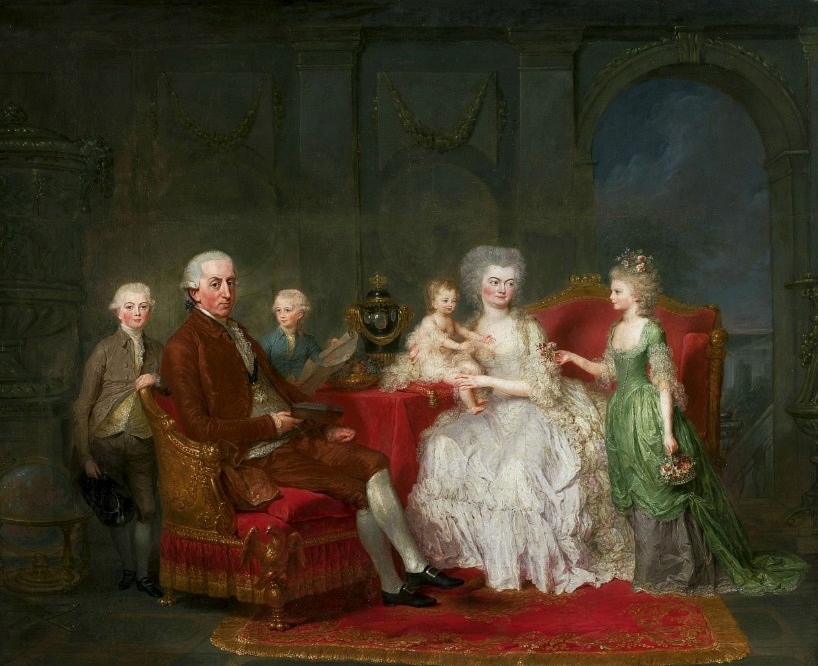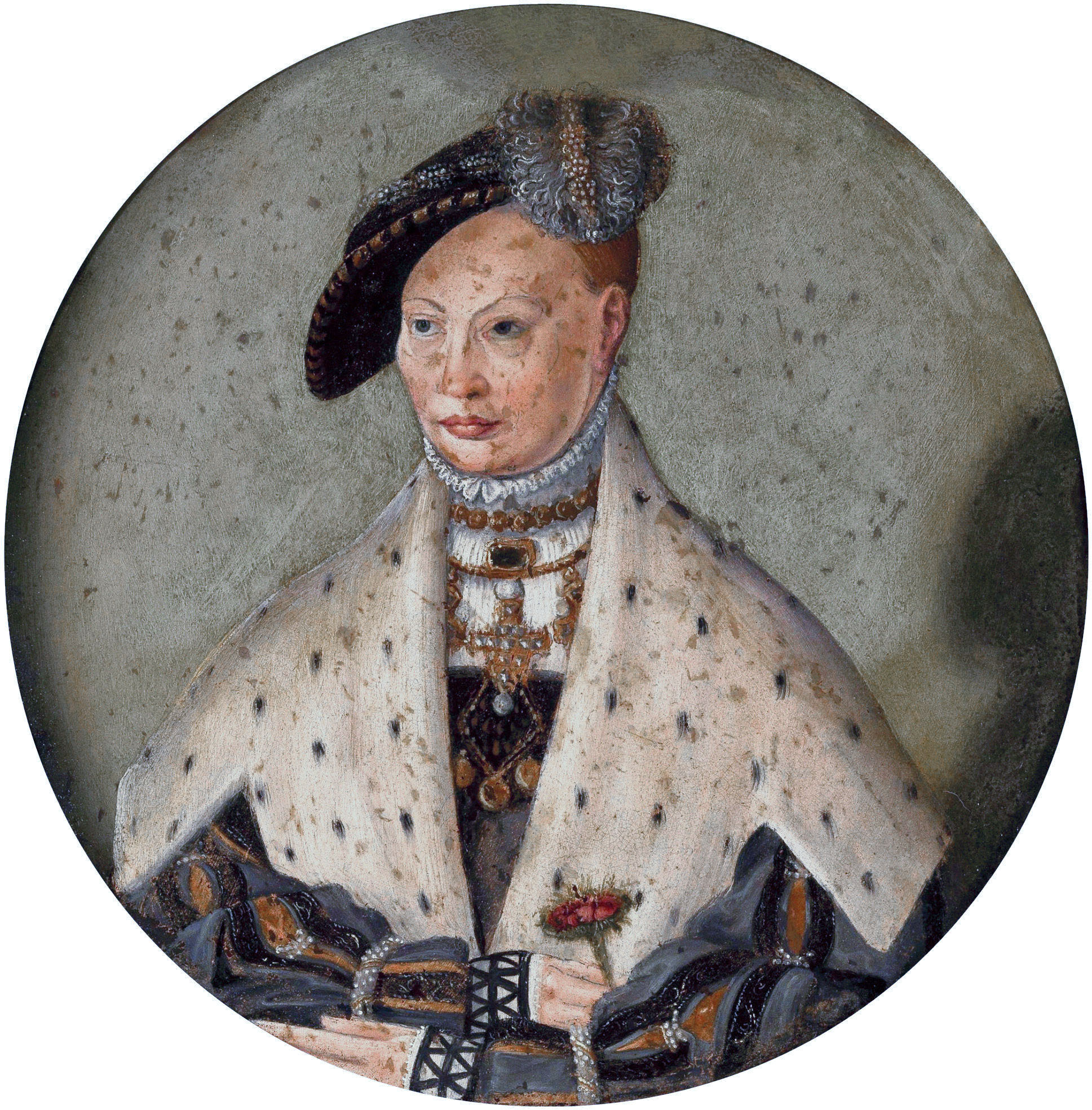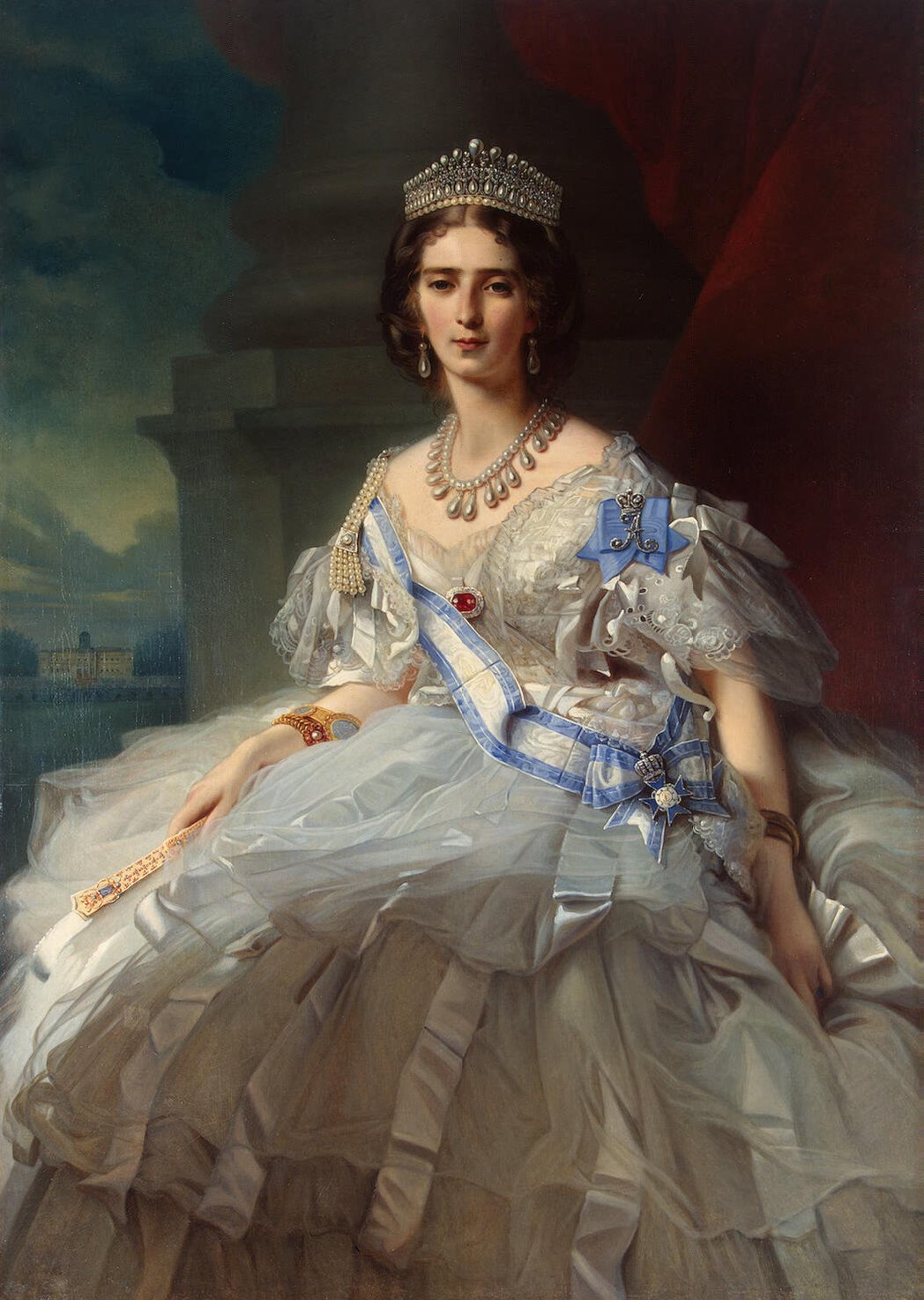|
Frederika Louisa Of Hesse-Darmstadt
Frederica Louisa of Hesse-Darmstadt (german: Friederike Luise; 16 October 1751 – 25 February 1805) was Queen of Prussia as the second spouse of King Frederick William II. Life Frederica Louisa was the daughter of Louis IX, Landgrave of Hesse-Darmstadt, and Countess Palatine Caroline of Zweibrücken. She was born in Prenzlau. She was the sister of Grand Duchess Louise of Saxe-Weimar-Eisenach, as well as Grand Duke Louis I of Hesse. Marriage Frederica Louisa was selected to marry Frederick William immediately after his divorce from Elisabeth Christine of Brunswick-Lüneburg, after Margravine Philippine of Brandenburg-Schwedt and Sophia Albertina of Sweden had been suggested. Her mother was highly admired by Frederick the Great. The wedding was performed on 14 July 1769 at the Charlottenburg Palace. Frederica Louisa was described as solid and sensible and with an agreeable conversation, though lacking of beauty and any particular intellectual abilities.Atkinson, E ... [...More Info...] [...Related Items...] OR: [Wikipedia] [Google] [Baidu] |
Queen Consort Of Prussia
The Queen of Prussia (german: Königin von Preußen) was the queen consort of the ruler of the Kingdom of Prussia, from its establishment in 1701 to its abolition in 1918. As all rulers of Prussia had to be male, there was never a Queen regnant of Prussia. Until 1806, the Queen of Prussia was also Electress of Brandenburg; after 1871, she was also German Empress. Until 1772, her title was ''Queen in Prussia'' (see King in Prussia). Duchess of Prussia Queens in Prussia Queens of Prussia Spouses of the pretenders See also *List of consorts of Brandenburg * List of German queens * Princess of Orange *Princess of Neuchâtel * Duchess of Saxe-Lauenburg * Grand Duchess of Posen * List of consorts of Hohenzollern *List of monarchs of Prussia {{DEFAULTSORT:List Of Prussian Consorts Prussia, List of consorts of Prussia, List of consorts of Consorts __NOTOC__ Consort may refer to: Music * "The Consort" (Rufus Wainwright song), from the 2000 album ''Poses'' * Consort ... [...More Info...] [...Related Items...] OR: [Wikipedia] [Google] [Baidu] |
Margravine Philippine Of Brandenburg-Schwedt
, house = Brandenburg-Schwedt , father =Frederick William, Margrave of Brandenburg-Schwedt , mother =Princess Sophia Dorothea of Prussia , birth_date = , birth_place =Schwedt , death_date = , death_place =Berlin } Margravine Philippine Auguste Amalie of Brandenburg-Schwedt (10 October 1745 – 1 May 1800) was a Landgravine consort of Hesse-Kassel by marriage to Frederick II, Landgrave of Hesse-Cassel. Life Philippine was one of five children born to Margrave Frederick William of Brandenburg-Schwedt and his wife Princess Sophia Dorothea of Prussia. Her siblings included Friederike Dorothea, Duchess of Württemberg and Elisabeth Louise, Princess of Prussia. Landgravine of Hesse-Kassel Philippine was very early on chosen by her aunt, Queen Louisa Ulrika of Sweden, as the future queen of Sweden; her mother was the queen's favourite, and Louisa Ulrika wished Philippine to marry her son, Gustav (later Gu ... [...More Info...] [...Related Items...] OR: [Wikipedia] [Google] [Baidu] |
Friederike Luise Of Prussia 03
Friederike is a feminine given name which may refer to: People *Friederike Sophie Wilhelmine of Prussia, Margravine of Brandenburg-Bayreuth (1709–1758), Prussian princess and older sister of Frederick the Great *Princess Friederike Luise of Prussia (1714–1784), Margravine of Brandenburg-Ansbach *Margravine Friederike of Brandenburg-Schwedt (1736–1798), Duchess of Württemberg *Princess Friederike of Hesse-Darmstadt (1752–1782), Duchess of Mecklenburg-Strelitz *Countess Friederike of Schlieben (1757–1827), Duchess of Schleswig-Holstein-Sonderburg-Beck *Princess Friederike of Schleswig-Holstein-Sonderburg-Beck (1780–1862), daughter of Friedrich Karl Ludwig, Duke of Schleswig-Holstein-Sonderburg-Beck * Princess Friederike of Schleswig-Holstein-Sonderburg-Glücksburg (1811–1902), daughter of Duke Friedrich Wilhelm of Schleswig-Holstein-Sonderburg-Glücksburg *Friederike Brun (1765–1835), Danish author and salonist *Friederike Caroline Neuber (1697–1760), German actor ... [...More Info...] [...Related Items...] OR: [Wikipedia] [Google] [Baidu] |
Wilhelm Ludwig Sayn-Wittgenstein
Wilhelm Ludwig Georg, Fürst zu Sayn-Wittgenstein-Hohenstein (October 9, 1770 - April 11 , 1851) was a Prussian statesman and confidant of Friedrich Wilhelm III who once held the post of Interior minister. With Karl Albert von Kamptz, the Justice minister, he contributed significantly to the end of the Prussian reforms and was one of the driving forces of the Restoration era in Prussia. Early life Born into an ancient House of Sayn-Wittgenstein, Wilhelm Ludwig was the second son and youngest child of Imperial Count Johann Ludwig zu Sayn-Wittgenstein-Hohenstein (1740-1796) and his wife, Countess Friederike Karoline Luise von Pückler-Limpurg (1738-1772), daughter of Count Christian Wilhelm Karl von Pückler-Groditz (1705-1786) and Countess Karoline Christiane von Löwenstein-Wertheim-Virneburg (1719-1793). Life He studied law at University of Marburg in 1786. After graduation, he became a courtier of Charles Theodore, Elector of Bavaria. Between 1797 and 1806, he was the O ... [...More Info...] [...Related Items...] OR: [Wikipedia] [Google] [Baidu] |
Wilhelmine, Gräfin Von Lichtenau
Wilhelmine, Gräfin von Lichtenau, born as Wilhelmine Enke, also spelled Encke (29 December 1753 in Potsdam – 9 June 1820 in Berlin), was the official mistress of King Frederick William II of Prussia from 1769 until 1797 and was elevated by him into the nobility. She is regarded as politically active and influential in the policy of Prussia during his reign. Biography The future Countess von Lichetenau's father, Johann Elias Enke, was a chamber musician in service of King Frederick II of Prussia. Wilhelmine met Crown Prince Fredrick William in 1764. The king preferred that the crown prince maintain a relationship with her rather than have changing relationships with foreign women, and in 1769, during which for most of the year she was 15 and he 24, she became the crown prince's official mistress. The couple had five children, of whom only the youngest survived to adulthood:«Wilhelmine Enke, the later Countess of Lichtenau». Discover Potsdam. Retrieved 20 May 2012. *A daughter ... [...More Info...] [...Related Items...] OR: [Wikipedia] [Google] [Baidu] |
Sophie Von Dönhoff
Countess Sophie Friederike Juliane von Dönhoff (17 October 1768 – 28 January 1838) was a German lady-in-waiting and a morganatic spouse by bigamy to King Frederick William II of Prussia. Early life She was the daughter of Count Friedrich Wilhelm von Dönhoff and Anna Sophie von Langermann und Erlencamp. Life In 1789, she became the lady-in-waiting of the Prussian queen, Frederika Louisa of Hesse-Darmstadt. Marriage She was described as a talented pianist and singer, admired for her attractive figure and said to be of an imperious disposition; she attracted the king's attention soon after the death of Julie von Voß, and insisted upon the same conditions as her predecessor, that is the consent of the queen to a "left-handed marriage" and a dowry.Atkinson, Emma Willsher: Memoirs of the queens of Prussia', London : W. Kent Sophie married Frederick at Charlottenburg Palace 11 April 1790. In contrast to Julie von Voß, who had behaved with discreet gentleness, ... [...More Info...] [...Related Items...] OR: [Wikipedia] [Google] [Baidu] |
Julie Von Voß
Julie Amalie Elisabeth von Voss (24 July 1766, Buch (Berlin) – 25 March 1789) was a German lady-in-waiting and a bigamous morganatic spouse of King Frederick William II of Prussia. Life She was the daughter of Friedrich Christian von Voss and Amalia Ottilia von Vieregg. Her uncle was chamberlain to the queen dowager. In 1783, she became lady-in-waiting to the Prussian queen, Frederika Louisa of Hesse-Darmstadt. She was nicknamed "Miss Bessy" at court as an anglophile, not regarded beautiful or clever, but fascinated the king by refusing his advances.Atkinson, Emma Willsher: Memoirs of the queens of Prussia', London : W. Kent She was persuaded to "sacrifice herself for the country" and accept the king by her relative Count Finckenstein, who wished to replace Wilhelmine von Lichtenau, with the argument that she would be able to save the king from the bad company of his circle. She accepted on condition that the queen's consent should be gained to a left-handed marriage with the ... [...More Info...] [...Related Items...] OR: [Wikipedia] [Google] [Baidu] |
Lady-in-waiting
A lady-in-waiting or court lady is a female personal assistant at a court, attending on a royal woman or a high-ranking noblewoman. Historically, in Europe, a lady-in-waiting was often a noblewoman but of lower rank than the woman to whom she attended. Although she may either have received a retainer or may not have received compensation for the service she rendered, a lady-in-waiting was considered more of a secretary, courtier, or companion to her mistress than a servant. In other parts of the world, the lady-in-waiting, often referred to as ''palace woman'', was in practice a servant or a slave rather than a high-ranking woman, but still had about the same tasks, functioning as companion and secretary to her mistress. In courts where polygamy was practised, a court lady was formally available to the monarch for sexual services, and she could become his wife, consort, courtesan, or concubine. ''Lady-in-waiting'' or ''court lady'' is often a generic term for women ... [...More Info...] [...Related Items...] OR: [Wikipedia] [Google] [Baidu] |
Bigamy
In cultures where monogamy is mandated, bigamy is the act of entering into a marriage with one person while still legally married to another. A legal or de facto separation of the couple does not alter their marital status as married persons. In the case of a person in the process of divorcing their spouse, that person is taken to be legally married until such time as the divorce becomes final or absolute under the law of the relevant jurisdiction. Bigamy laws do not apply to couples in a de facto or cohabitation relationship, or that enter such relationships when one is legally married. If the prior marriage is for any reason void, the couple is not married, and hence each party is free to marry another without falling foul of the bigamy laws. Bigamy is a crime in most countries that recognise only monogamous marriages. When it occurs in this context often neither the first nor second spouse is aware of the other. In countries that have bigamy laws, with a few exceptions (suc ... [...More Info...] [...Related Items...] OR: [Wikipedia] [Google] [Baidu] |
Honoré Gabriel Riqueti, Comte De Mirabeau
Honoré Gabriel Riqueti, Count of Mirabeau (; 9 March 17492 April 1791) was a leader of the early stages of the French Revolution. A noble, he had been involved in numerous scandals before the start of the Revolution in 1789 that had left his reputation in ruins. Nonetheless, he rose to the top of the French political hierarchy in the years 1789–1791 and acquired the reputation of a voice of the people. A successful orator, he was the leader of the moderate position among revolutionaries by favoring a constitutional monarchy built on the model of Great Britain. When he died (of natural causes), he was a great national hero, even though support for his moderate position was slipping away. The later discovery that he was in the pay of King Louis XVI and the Austrian enemies of France beginning in 1790 brought him into posthumous disgrace. Historians are deeply split on whether he was a great leader who almost saved the nation from the Terror, a venal demagogue lacking political ... [...More Info...] [...Related Items...] OR: [Wikipedia] [Google] [Baidu] |
Wilhelmine Von Lichtenau
The Wilhelmine Period () comprises the period of German history between 1890 and 1918, embracing the reign of Kaiser Wilhelm II in the German Empire from the resignation of Chancellor Otto von Bismarck until the end of World War I and Wilhelm's abdication during the November Revolution. It affected the society, politics, culture, art and architecture of Germany and roughly coincided with the Belle Époque era of Western Europe. Overview The term "Wilhelminism" (''Wilhelminismus'') is not meant as a conception of society associated with the name Wilhelm and traceable to an intellectual initiative of the German Emperor. Rather, it relates to the image presented by Wilhelm II and his demeanour, as manifested by the public presentation of grandiose military parades and self-aggrandisement on his part. The latter tendency had already been noticed by his grandfather, Emperor Wilhelm I, while the latter's father, later Frederick III, was Crown Prince. Wilhelminism also characterize ... [...More Info...] [...Related Items...] OR: [Wikipedia] [Google] [Baidu] |




